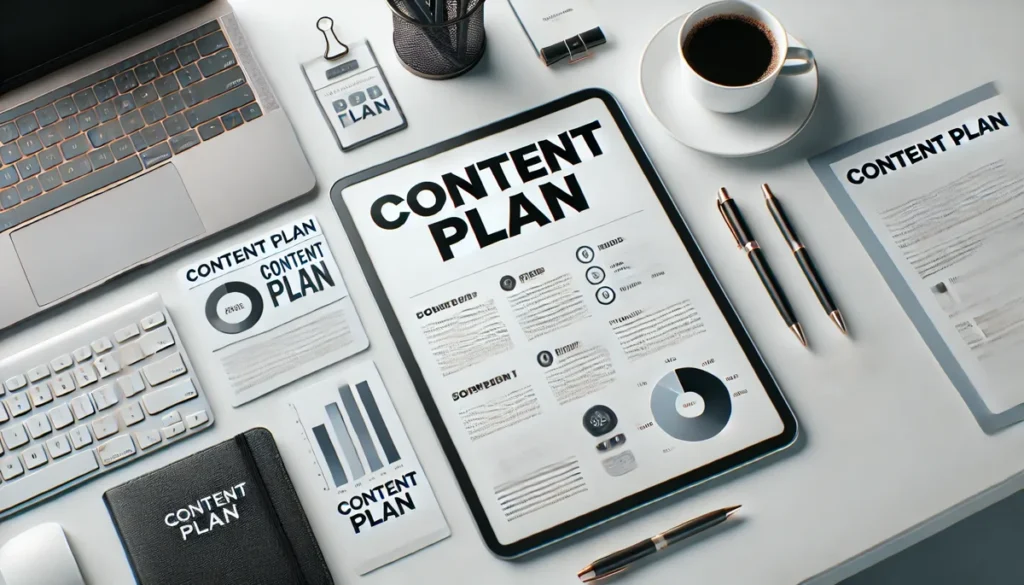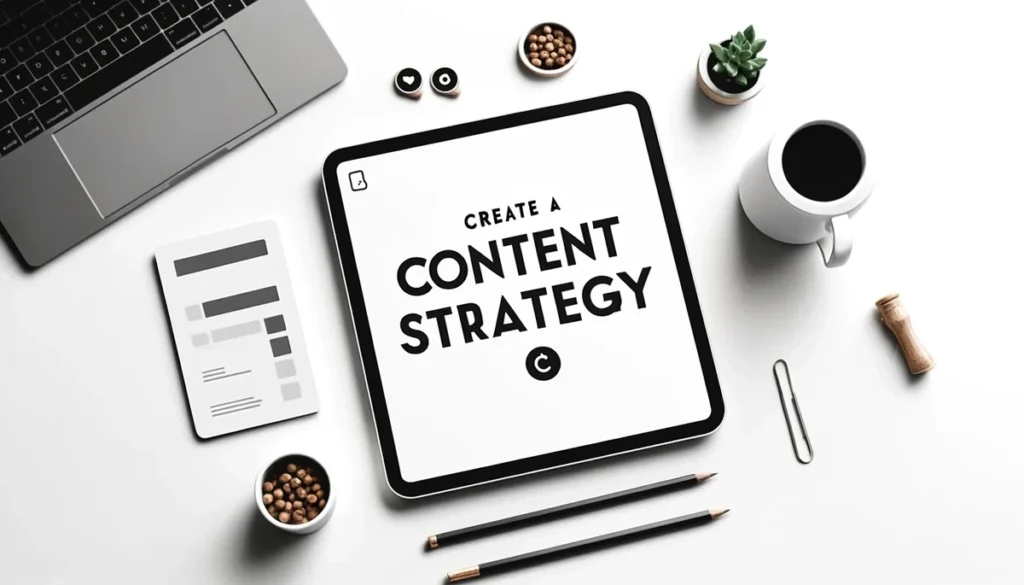
A well-structured content plan is crucial for standing out and achieving sustainable growth. A SaaS content plan acts as a strategic roadmap, guiding your content creation efforts to align with your business goals and resonate with your target audience. With a clear plan in place, you can effectively manage your content resources, streamline your marketing efforts, and drive more engagement, conversions, and customer loyalty.
In this article, we go through the journey of crafting an effective SaaS content plan. We will use tips and strategies that have worked for us and our clients here at SGL.
In a Nutshell: Crafting an Effective SaaS Content Plan
Here’s a summary of what you’ll learn:
- Importance of a Content Plan: A well-structured SaaS content plan is essential for aligning your content creation with business goals and ensuring sustainable growth.
- Understanding Your Audience: Start by defining and understanding your target audience through detailed buyer personas, mapping out the customer journey, and analyzing audience behavior and feedback.
- Defining Content Goals: Set clear, measurable content goals that align with your business objectives, such as increasing brand awareness, generating leads, or retaining customers.
- Developing the Content Plan: Conduct a content audit to identify strengths and gaps, choose the right content types and formats, and create a content calendar to organize your publishing schedule.
- SEO and Content Quality: Write high-quality, SEO-friendly content with compelling headlines and optimized keywords to improve visibility and engagement.
- Utilizing Visuals and Multimedia: Enhance your content with visuals, video content, and multimedia elements to make it more engaging and easier to understand.
- Continuous Improvement: Regularly monitor performance metrics and gather audience feedback to refine your content strategy over time.
This summary outlines the key elements—keep reading for a more detailed exploration!
Let’s jump right in!
Identifying and Understanding Your Ideal SaaS Audience
A successful SaaS content plan starts with a clear understanding of your audience. Follow these actionable steps to define and understand your target audience effectively:
1. Create Detailed Buyer Personas
Gather data from customer surveys, interviews, and website analytics. According to HubSpot, businesses using buyer personas in their marketing strategies saw website traffic increase by 210%.
Identify common traits among your best customers, such as age, job title, industry, and company size.
Understand their goals and challenges. Are they looking to improve efficiency, reduce costs, or drive growth?
Use this knowledge to create content that addresses their specific needs and aspirations.
2. Map Out the Customer Journey

Identify the different stages your audience goes through, from awareness to decision-making.
Determine their needs and questions at each stage. For example, during the awareness stage, they might look for educational content to better understand their problems.
Provide case studies or comparison guides during the consideration stage and product demos and pricing information during the decision stage. Research by HubSpot shows that 67% of buyers want clear and straightforward information about the product’s benefits.
Tailor your content to provide the right information at the right time.
3. Analyze Audience Behavior
Use tools like Google Analytics, social media insights, and CRM data.
Look at metrics such as page views, time spent on pages, and social media engagement to understand what type of content resonates most with your audience.
Track which topics generate the most interest and which formats (blog posts, videos, infographics) are most effective.
Refine your content strategy based on these insights to better meet audience preferences.
4. Conduct Market Research
Use online surveys, focus groups, and interviews to gather qualitative data.
Ask open-ended questions to uncover specific challenges, needs, and preferences.
Pay attention to the language they use to describe their problems and solutions. This approach was validated by Harvard Business Review, which found that customer language significantly increases engagement.
Create content that speaks directly to them, using their own language and addressing their specific concerns.
5. Gather Feedback from Existing Customers
Regularly gather feedback through customer satisfaction surveys, support interactions, and feedback forms.
Understand what they find valuable about your product and what areas need improvement.
Use this feedback to improve your product and guide your content creation efforts.
Address real customer concerns and enhance satisfaction with targeted content.
Following these steps allows you to thoroughly identify and understand your ideal SaaS audience. This targeted approach builds trust, fosters engagement, and drives conversions, ultimately supporting your business growth and success.
Defining Goals and Crafting a Sample Content Plan
Now that we understand our target audience, the next step is to craft a sample content plan. Setting clear goals and creating a tangible content plan is essential for the success of your SaaS content strategy. Follow these steps to ensure your content efforts are aligned with your business objectives:
1. Define Your Content Goals
Determine what you want to achieve with your content. Common goals include increasing brand awareness, generating leads, and retaining customers.
Be specific and set measurable goals. For example, aim to increase website traffic by 20% in the next six months or generate 50 new leads per month.
2. Align Content with Business Objectives
Map your content to different stages of the sales funnel. For example, create blog posts and educational content for the awareness stage, case studies and comparison guides for the consideration stage, and product demos and pricing information for the decision stage.
Ensure each piece of content supports your overarching business goals. For instance, if your goal is lead generation, focus on creating gated content like eBooks and webinars that require users to submit their contact information.
3. Set Measurable KPIs
Identify key performance indicators (KPIs) that will help you track the success of your content. Examples include website traffic, social media engagement, lead generation, and conversion rates.
Regularly monitor these KPIs to assess the effectiveness of your content and make data-driven adjustments as needed.
4. Craft a Sample Content Plan
Develop a content calendar that outlines your content creation and publication schedule. Include details such as topics, formats, target audience, and publication dates.
Plan a mix of content types and formats, such as blog posts, whitepapers, eBooks, videos, and webinars. This variety keeps your audience engaged and caters to different preferences.
Use project management tools like Trello, Asana, or Monday.com to organize your content calendar and track progress.
Sample Content Plan Example:
| Week | Content Type | Topic | Target Audience | Goal |
| Week 1 | Blog Post | “Top 5 Challenges in SaaS and How to Overcome Them” | SaaS startups and decision-makers | Awareness |
| Week 2 | Webinar | “Boosting SaaS Customer Retention with Effective Strategies” | SaaS product managers and marketers | Lead Generation |
| Week 3 | Case Study | “How XYZ Company Increased Their Revenue by 30% Using Our SaaS Solution” | Potential customers in similar industries | Consideration |
| Week 4 | eBook | “The Ultimate Guide to Scaling Your SaaS Business” | SaaS entrepreneurs and executives | Lead Generation |
Setting clear goals and crafting a detailed content plan ensures your content strategy is focused and effective. This approach helps you achieve your business objectives, engage your audience, and drive measurable results.
Steps to Develop an Effective SaaS Content Plan
Developing a robust SaaS content plan involves several key steps. Each step is crucial to ensuring your content strategy is comprehensive and impactful. Follow these detailed steps to create a content plan that aligns with your business goals and resonates with your audience.
Step 1: Conduct a Content Audit
- Review Existing Content: Start by evaluating your current content to determine what’s working and what isn’t. Use analytics tools to measure performance metrics such as page views, engagement rates, and conversion rates.
- Identify High-Performing Content: Highlight content that has performed well. Look for patterns in topics, formats, and distribution channels that contribute to success.
- Spot Content That Needs Improvement: Find underperforming content that could be updated or improved. Consider refreshing outdated information, enhancing SEO elements, or improving the overall quality.
- Look for Content Gaps: Identify topics that are missing or underrepresented in your current content library. Consider the questions and needs of your audience that you haven’t yet addressed.
Step 2: Identify Content Gaps
- Analyze Current Content: Compare your existing content against the needs and interests of your target audience. Identify areas where your content is lacking or not meeting the audience’s expectations.
- Use Keyword Research Tools: Tools like Google Keyword Planner, SEMrush, or Ahrefs can help you discover what your audience is searching for. Identify high-volume, low-competition keywords that you haven’t yet targeted.
- Study Competitor Content: Look at your competitors’ content to see what topics they cover that you do not. Identify opportunities to cover these topics from a unique angle or with added depth.
- Gather Audience Feedback: Directly ask your audience what topics they are interested in through surveys, social media, or customer feedback forms. Use this information to guide your content creation.
Step 3: Choose Content Types and Formats
- Determine Content Types: Decide on the content types that will best meet your audience’s needs. Options include blog posts, whitepapers, eBooks, videos, webinars, and case studies.
- Diversify Content Formats: Cater to different audience preferences by offering a variety of formats. For instance, turn a popular blog post into a video or an infographic to reach a broader audience.
- Plan for Repurposing Content: Maximize the value of your content by repurposing it into different formats. For example, a webinar can be transcribed into a blog post, or key points from an eBook can be turned into a series of social media posts.
Step 4: Create a Content Calendar
- Develop a Detailed Schedule: Outline your content creation and publication schedule. Include topics, formats, target audience, publication dates, and responsible team members.
- Ensure Consistency: A content calendar helps you maintain a consistent publishing schedule, which is crucial for keeping your audience engaged and building trust.
- Use Project Management Tools: Tools like Trello, Asana, or Monday.com can help you organize your content calendar, assign tasks, and track progress to ensure deadlines are met.
- Plan for Flexibility: Allow some flexibility in your content calendar to accommodate timely topics, industry trends, or unforeseen events that may be relevant to your audience.
Step 5: Write High-Quality, SEO-Friendly Content
- Conduct Keyword Research: Identify relevant keywords and phrases that your audience is searching for. Use these keywords naturally in your content to improve visibility in search engines.
- Craft Compelling Headlines: Create headlines that capture attention and encourage readers to engage with your content. Make them clear, concise, and benefit-driven.
- Maintain Readability: Use clear and concise language. Break up text with headings, bullet points, and visuals to make it easy to read and understand.
- Engage the Audience: Write in a conversational tone and include calls-to-action (CTAs) to encourage interaction. Ask questions, invite comments, and prompt readers to share your content.
- Optimize for SEO: Incorporate on-page SEO best practices, such as using keywords in titles, meta descriptions, headers, and throughout the content. Ensure your content is properly formatted with alt text for images and includes internal and external links.
Step 6: Utilize Visuals and Multimedia
- Enhance Content with Visuals: Use images, infographics, and charts to make your content more engaging and easier to understand. Visuals can help illustrate complex ideas and keep readers interested.
- Leverage Video Content: Videos can provide in-depth explanations, product demonstrations, or customer testimonials. They are highly engaging and can improve your audience’s understanding and retention of the information.
- Integrate Multimedia Elements: Complement your written content with multimedia elements. This provides a richer experience for your audience and caters to different learning styles.
- Optimize Multimedia for SEO: Ensure that all visuals and videos are optimized for search engines by using descriptive file names, alt text, and proper tagging.
Following these detailed steps will help you develop a comprehensive and effective SaaS content plan. This structured approach ensures your content strategy is aligned with your business goals, resonates with your audience, and drives measurable results.
Conclusion
In conclusion, developing a robust SaaS content plan is pivotal for engaging your audience effectively and achieving your business objectives. Conducting a thorough content audit, identifying content gaps, and selecting appropriate formats establish a strong foundation for creating content that resonates with your target audience. Crafting a detailed content calendar ensures consistency and enables strategic planning, while leveraging SEO and multimedia enhances content visibility and engagement.
Furthermore, the iterative nature of content development requires continuous monitoring of performance metrics and audience feedback. This ongoing assessment allows for refinement of your strategy over time, ensuring that your content remains relevant and impactful. Ultimately, a well-executed content plan enhances brand authority and drives customer acquisition and retention, contributing to sustained business growth in the competitive SaaS landscape.


